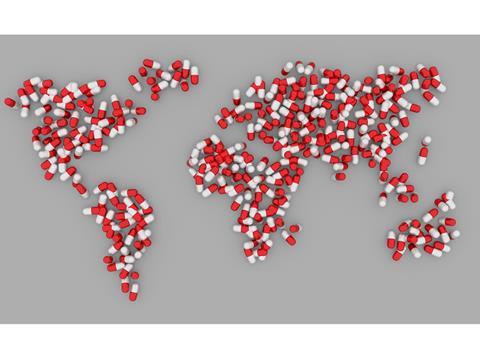
In the first of a series of articles ahead of NEXUS 17 (the annual forum that gathers pharmaceutical supply chain leaders to shape the future of track and trace), Tim Sykes interviews Prateek Lal, CEO of Adept Packaging – one of the key players at the forum.
Tim Sykes:
I’d like to ask about the drivers of serialisation, starting with compliance. How well prepared do you think the pharma industry is for the respective US and EU deadlines?
Prateek Lal:
Governments and the FDA started mandating serialisation to improve patient safety by reducing counterfeiting and securing the pharmaceutical supply chain.
Until only a few years ago, most companies were focusing purely on compliance - they knew they had to serialise and were motivated to comply in the least disruptive and expensive manner. That driver has evolved significantly, and today companies are actively focused on extracting strategic value- adds from a serialised supply chain such as brand security, process improvements, chargebacks and management.
In terms of preparedness, the situation varies from company to company. The largest global pharmaceutical companies have spent considerable time and money to prepare and will mostly be ready by the US deadline in November. Many smaller companies, virtual companies and generic companies, started late, did not plan properly, did not staff their serialisation team properly and are now struggling.
We also have to consider the risk exposure of pharmaceutical companies to external manufacturers. For some companies, a significant portion of their volume is packaged by CMO /CPOs. Pharmaceutical companies very often cannot fully control the serialisation readiness of their CMOs /CPOs so they have no very effective ways to mitigate that risk. Many small CMOs and CPOs started extremely late and are at risk of not meeting the deadlines. We have had multiple situations when pharmaceutical companies had to initiate product transfers from a CMO/CPO due to a risk of non-compliance to CMOs/CPOs with proven serialisation capabilities.
Europe has a couple of additional years compared to the US; however, the supply chain in Europe is particularly fragmented, and the issue of CMO/CPO readiness is even more serious.
TS:
Is it possible to quantify the value accruing to pharmaceutical manufacturers from serialisation thanks to the security benefits?
PL:
Business consultancy companies have conducted numerous studies to identify the value of serialisation within the supply chain, from manufacturing and packaging through distribution, recalls, returns and chargebacks. The value is there and it has been identified and quantified fairly well.
The issue is that the value of serialisation is related to the ‘network effect’ in the sense that we will all get value out of serialisation once everybody has adopted serialisation and serialisation-driven business processes. At that point, actual track and trace will be possible and the benefits estimated in the many business cases that have been developed will come to fruition. There is a ‘wait and see’ attitude among many companies in regards to implementing more advanced track and trace programs because the industry as a whole is not there yet. For example, email also was a great idea, however, it only became economically useful once enough companies adopted it, building the ‘network effect’.
We are seeing companies focus on the highest returns and implementing programs to achieve those, such as chargebacks.

TS:
Do you have the sense that the end user or patient also sees the value of serialisation?
PL:
Everything we are doing is precisely for the patient, to make them trust the medications they use, to make sure that they get the right medicine, in the prescribed dose, not expired or counterfeit.
However, end users and patients seem largely unaware about serialisation, the benefits or that serialised units will be sold very soon. Sometimes when I see a doctor I am asked what I do and when I explain the concept of serialisation they are always fascinated and they get it right away.
I think that the industry has the opportunity to ‘sell’ the benefit of serialisation to patients and providers. With serialisation followed by electronic Pedigree, which is coming to the US soon after we start serialising, we can give the end user the possibility to authenticate with their smart phone any medicine that they will take. That is a pretty amazing story!
TS:
What are the technological and organisational challenges in implementing serialisation, and can you outline Adept’s best practice approach to helping your clients?
PL:
This is a great question. Serialisation impacts all aspects of the pharma business. The impact starts with the generation, or receipt from a third party, of the serial numbers. In order to do so, new software and systems must be put in place and validated, both at the corporate level and at the plant and warehouse level.
Processes in the serialised supply chain are very different than in the non-serialised supply chain, particularly when you introduce item to case to pallet aggregation.
New standard operating procedures (SOPs) must be developed to manage the packaging line, to manage QA, sampling, item and case pick and pack. All necessary changes must be implemented at the IT level and packaging line level. For example, global trade item numbers (GTINs) must be defined and stored in systems, serial numbers must be generated, exchanged, managed and sent to the packaging line.
Some of the most disruptive IT changes occur at the packaging line level. New software and hardware must be installed to ‘consume’ serial numbers at the line level, to print and verify, to perform case aggregation and to collect serial numbers that are actually used. The line system must be connected to higher level (Level 3 and 4) systems where serial numbers and serialisation events are ultimately managed and stored.
We at Adept have done numerous projects and have developed a series of best practices working together with our clients. The body of work was so significant that we realised we really had a lot of intellectual property in our hands and that we needed to structure it to better leverage it across projects.
Our solution was to standardise our approach to serialisation and to develop an ‘accelerator’, CMO ProTrack. CMO ProTrack is a turn-key solution designed to enable pharmaceutical serialisation teams to execute successful serialisation implementation at CMOs.
CMO ProTrack offers step-by-step implementation methodology and GxP pre-written documentation templates developed with years of experience and expertise. We estimate that we spent over 25,000 hours in developing the processes and the content of all the documents so that our customer can implement serialisation faster, at lower cost and at with considerable risk reduction.
TS:
Where are the biggest opportunities for traceability to add value in CPG outside the pharma/medical segment?
PL:
Traceability is an important means to improve efficiency in the supply chain by providing product visibility at all points and inventory (and customer demand) data at the stock keeping unit (SKU) level. Such granular information allows more precise supply chain modelling and, ultimately, allows for an optimisation of inventory levels and manufacturing.
We always thought that pharma was just the beginning for traceability. Driven by mandates the pharma industry would drive the maturity of serialisation and track and trace technology and its ecosystem of vendors, increasing its attractiveness for other industries.
We think that traceability will be used in CPG, food and beverage whenever it can reduce health hazards, for example. We see some activities going on in traceability for seafood and fresh produce.
Recall management also offers a great opportunity for the implementation of end to end traceability. Food companies typically have recall practices in place with data from ‘one down, one up’ in the supply chain, just the most immediate supply chain points. The real value is applying traceability from farm (or plant) to fork. That is the only way we can avoid the next peanut butter scare.
TS:
What are the most important issues you want to talk about – and hear about – at NEXUS 17?
PL:
This year’s NEXUS is in Europe and that is for very important reason: we would like to get a better understanding of where European companies are in their serialisation journey. For this NEXUS, however, we have a very specific focus: CMOs & CPOs.
Pharmaceutical companies often use a large network of CMOs/CPOs, each with varying capabilities to add new software and hardware and to exchange serialisation data with their clients. This makes it complex for a pharma company to manage the ‘onboarding’ of the CMOs/CPOs to their serialisation program and to align their CMOs/CPOs’ readiness with their own plans. The most complex components of serialisation are the tight collaboration and interdependencies among all stakeholders and pharmaceutical companies are exposed to the risk from their CMOs/CPOs not being able to become serialisation enabled on time.
TS:
Could you give me an overview of Adept’s business and services (including your broader packaging consultancy and co-packing support)?
PL:
Adept Packaging consists of a team of experts in packaging and packaging enabled technologies like serialisation. We are a global consultancy with wholly owned operations in the United States and Europe that collectively provide more than 100,000 annual hours of technical services to the world’s most respected companies and iconic brands.
Our consulting, technical development and staffing services deliver value through packaging strategy, innovation, cost optimisation, and technology deployment in the food, beverage, CPG and life sciences industries. The Adept Packaging team is recognised for delivering our clients’ goals and enabling them to embolden their strategy knowing they have Adept Packaging’s extensive packaging knowledge and expertise to successfully deliver.
Packaging Europe will be reporting from NEXUS 17, which takes place on 7-8 June 2017 in Barcelona.














